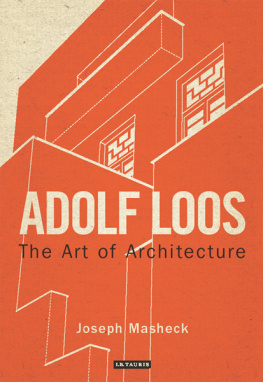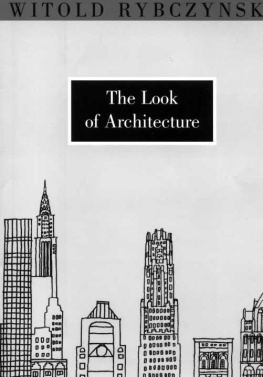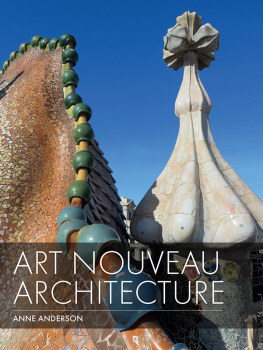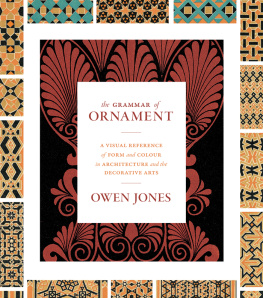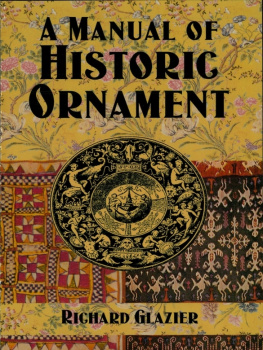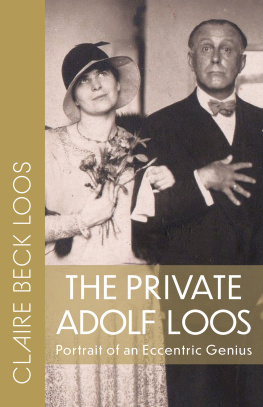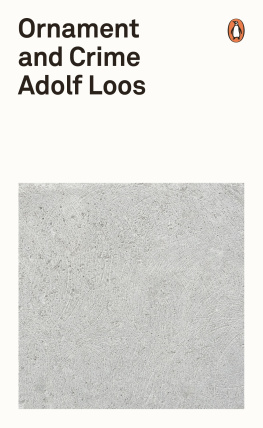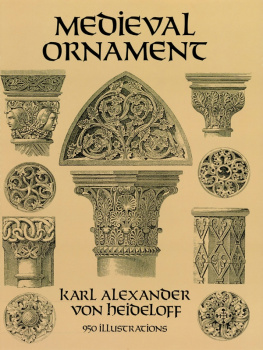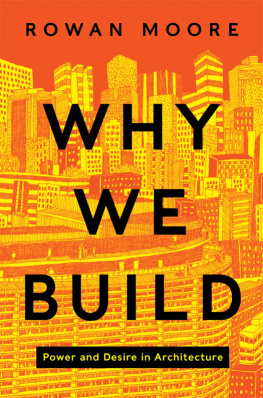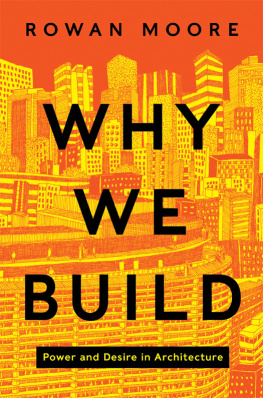
Joseph Masheck , MLitt ( D UBL ), PhD, has taught at Columbia, Harvard and, as Professor of Art History, at Hofstra University, Hempstead, New York. A former editor-in-chief of Artforum , he has been a Guggenheim Fellow, Centenary Fellow of Edinburgh College of Art (University of Edinburgh) and visiting fellow at St Edmunds College, Cambridge University. Previous books include Building-Art: Modern Architecture Under Cultural Construction (1993), Marcel Duchamp in Perspective , 2nd edn (2002), The Carpet Paradigm: Integral Flatness from Decorative to Fine Art (2010) and Texts on (Texts on) Art (2011).
Joseph Masheck wears his erudition with wonderful wit. His ambition to reclaim Loos for art comes across with vigor and passion. To paraphrase Adolf Loos, a monument isnt an everyday occurrence but something that makes you stop and take notice. Mashecks new book is a monumental contribution to the Loos literature ambitiously conceived, thoroughly provocative, and deeply insightful.
Joan Ockman, Distinguished Senior Fellow,
School of Design, University of Pennsylvania
Mashecks fresh interpretation of the work of Adolf Loos places the emphasis on the specific nature of his architecture rather than on the cultural scope of his critical writing. In so doing he demonstrates not only how Looss work was influenced by very varied traditions ranging from Biedermeier to Art Nouveau, but also how his abstract approach to form anticipated in a specific way the discourse of American minimalist art.
Kenneth Frampton, Ware Professor of Architecture,
Columbia University
This is a provocative take on Adolf Loos at a time when criticism has exhausted its theoretical resources, and the near past seems almost out of reach. Each chapter of the book disbands the established interpretive canons if only to proclaim a diachronic affinity between Loos, Constructivism and Minimalism of the 1960s. Joseph Masheck is cogent and persuasive.
Gevork Hartoonian, Professor of Architecture,
University of Canberra
Proto-minimalist or Architectural Dadaist? The enemy of ornament or the last classicist? Who better than Joseph Masheck in this penetrating book to guide us round the paradoxes of this dandified enemy of ornamental invention, whose most prominent masterpiece is a bronze-and-marble colonnaded gentlemens outfitter!
Joseph Rykwert, Cret Professor of Architecture Emeritus,
University of Pennsylvania
Published in 2013 by I.B.Tauris & Co Ltd
6 Salem Road, London W2 4BU
175 Fifth Avenue, New York NY 10010
www.ibtauris.com
Distributed in the United States and Canada Exclusively by Palgrave Macmillan
175 Fifth Avenue, New York NY 10010
Copyright 2013 Joseph Masheck
The right of Joseph Masheck to be identified as the author of this work has been asserted by him in accordance with the Copyright, Designs and Patents Act 1988.
All rights reserved. Except for brief quotations in a review, this book, or any part thereof, may not be reproduced, stored in or introduced into a retrieval system, or transmitted, in any form or by any means, electronic, mechanical, photocopying, recording or otherwise, without the prior written permission of the publisher.
International Library of Architecture: 1
ISBN: 978 1 78076 423 8 (PB)
ISBN: 978 1 78076 422 1 (HB)
eISBN: 978 0 85773 321 4
A full CIP record for this book is available from the British Library
A full CIP record is available from the Library of Congress
Library of Congress Catalog Card Number: available
Typeset in Perpetua by freerangeproduction.com
In memoriam
OTTOKAR UHL
(1931 Wolfsberg in Krnten2011 Vienna)
ILLUSTRATIONS
Every effort has been made to gain permission for the use of the images in this book. Any omissions will be rectified in future editions.
PREFACE
The buildings and writings of Adolf Loos (18701933) are now often enough taken, or mistaken, in the cultural sphere, as exemplary of an early modern iconoclasm which, if not downright nihilistic, was out to deny art as such, as if with some Dadaist form of anti-architecture. In spite of a longstanding interest in Duchamp, I always suspected that Loos was something more than simply the Duchamp of architecture; but how so? Considering aspects of his contribution, the present book offers makings of an answer. Not that Loos wasnt iconoclastic; but his was the witty and knowing iconoclasm of the believer, on behalf of the great art of architecture. Against the commonplace of Loos as mere ironist, part of the history of architecture possibly only as a critical curmudgeon clearing the way to modernism rather than as building and advancing it, the following thematic essays take off from the assumption that as a practitioner Loos belongs as much to the history of art as any other great modern artist.
Kenneth Frampton offers a uniquely qualified double negative, speaking of the dissolution of classical aesthetics by both the positive and the negative avant-garde, sometimes to perversely sublime effect, of Duchamps anti-painting painting or Adolf Looss anti-architecture architecture. He points up how Loos makes a distinction between architecture and art in his Architecture essay of 1910, oscillat[ing] between describing the house as conservative and the art work, art, as subversive, only to end with this beautiful and ironic passage, and so the man loves his house and hates art. Indeed there is irony there, and it is not at odds with art. Architecture also salutes the great romantic-classicist of a hundred years before, Karl Friedrich Schinkel; and if the Loos of 1910 seems not to vie with Schinkel in sublimity, his genuine artfulness has been sufficiently forgotten, notwithstanding his latter-day cultural celebrity, for him to deserve in his own right, now a century later still, some of the honor of his own memorable salute to Schinkel: May the light of this towering figure shine upon our forthcoming generation of architects! It doesnt matter that Loos never got to build the projected public buildings which to his mind might have justified that; his informal modern formalism was the lesson which was needed, and may well be again.
In New York, Loos had to wash dishes for pocket money, and part of the time he slept in a YMCA: what a waste it would have been to struggle through that just to make jokey, one-liner art. No; Looss sarcasm never got the better of his wit, nor his wit of his intelligence. He did as much as any other architect after Otto Wagner, the grand old Viennese master of the prior generation, to bring forth modernism at the opening of the twentieth century. A relative youngster who took to calling himself Le Corbusier was one whose art this supposed non-artist influenced. Loos showed how the end of the established academic tradition, far from implying the end of what was entitled to be considered the art, might allow the new modern architecture to inherit what truth of the old tradition deserved to survive.
Philosophically, his skeptical outlook and blunt eschewal of obfuscation sometimes affiliate Loos with the tougher-than-thou logical positivism of the Vienna Circle, which sought to clean up modern life by taking out the presumed rubbish of metaphysics. Extreme architectural functionalism, which Loos made possible but to which he himself was not constrained, was similarly framed as a truth of which only those strong enough to live value-free were worthy. However, the more one considers even his most radical architecture, the less like a standard functionalist Loos seems. If anything, he parallels less the logical positivist Rudolf Carnap than the Ludwig Wittgenstein who actually drew back from the Vienna Circle which he had helped to make possible. Even where Loos notoriously states that at least the private house should not be a matter of art, it would be as dangerous as with Nietzsche, not to mention Looss friend Karl Kraus, to lose track of the ironists deft control of meaning. Looss standing caricature was inevitably encouraged by his delight in playing the outrageous avant-gardist: the posture which this really very much true architects most famous text, Ornament and Crime, perpetrated to the distraction of all else.
Next page
